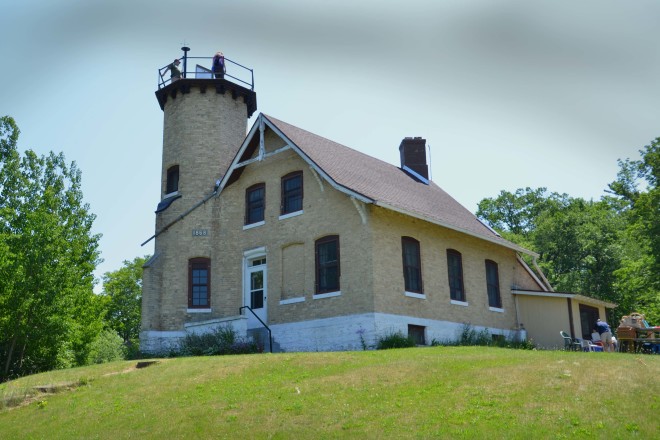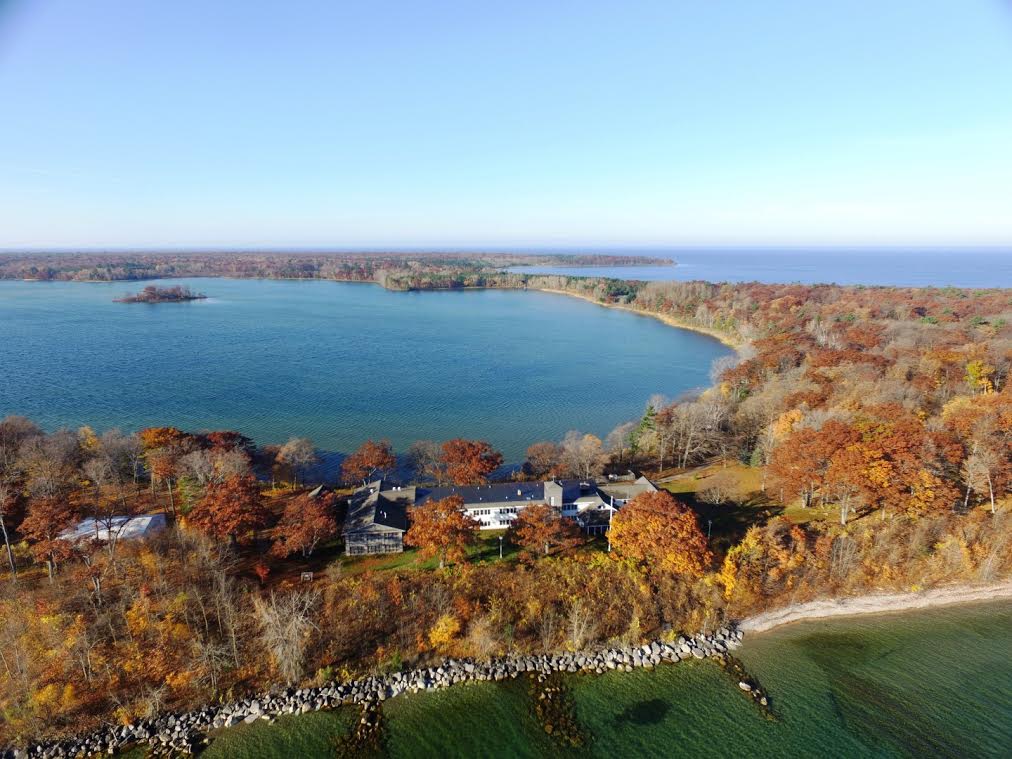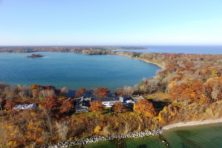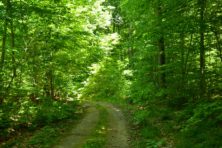Forgotten Charms of Chambers Island
- Share
- Tweet
- Pin
- Share

In 1860, one organized town in Door County had a population of 46 whose voters, according to Door County historian Hjalmar Holand, “gathered once a year in solemn concave to discuss the needs of the roads and bridges, distribute political honors and damn the state tax.”
It had a full array of state officers with no less than three justices of the peace, a town constable and even a Sealer of Weights and Measure. It had a public school and a post office, farms, orchards, livestock, a sawmill and a shipbuilding plant. It had a sewing circle, frequent tea parties and occasional religious services. Can you guess the town this describes?
If you guessed any place other than Chambers Island, you’d be mistaken.

A plat map of Chambers Island from 1937.
The island, 3.5 miles long and 1.5 miles wide, lies in Green Bay about seven miles off the mainland, with Fish Creek as the closest community.
Mary Ann Blahnik and her husband, Joel, have served as volunteer caretakers of the Chambers Island Lighthouse for more than 40 years.
The Blahniks’ interest in the island grew out of Joel’s job in the 1950s as captain of the Ephraim Excursion Boat. His twice-weekly excursions to the island included brown bag lunches from Al Johnson’s Swedish Restaurant and a narrated bus tour. In 1976, Joel closed his charter fishing business and became captain of the Quo Vadis, which for 28 years took people to the Holy Name Retreat House on the island. That was also the year the lighthouse was transferred by the U.S. government to the Town of Gibraltar, and the Blahnik family, including three children and a dog, became summer residents of the lighthouse.
Today, the island has its own CIA (Chambers Island Association) that holds an annual meeting and picnic at the lighthouse the first weekend in August. There’s a chili cook-off in September, garage floor pourings (in the manner of old-fashioned barn raisings), weddings, baptisms and square dances with participants from eight to 80, led by retired physical education teacher Carol Kennedy.
Mary Ann invites mainlanders and tourists to “stop by when you’re in the neighborhood.”
Fascinating Facts
- The island has two lakes – spring-fed, 350-acre Makaysee and Lost (or Mud) Lake, more like an oversized pond. In 1941, it was the scene of a tragedy when two Gibraltar students drowned during an FFA outing. Lake Makaysee is unusual in that it has an island with two small lakes. There’s a rumor that these “islands in a lake on an island in the bay” is in the Guinness Book of Records, but Mary Ann has not been able to verify it.
- The island has about 60 cottages and summer homes and the Holy Name Retreat House, which ceased operation in 2014. Nobody lives there year round, and only one couple spends the entire summer.
- Paleo-indians are believed to have lived here at least 12,000 years ago. In 1975, a man from Michigan claimed to have found a spearhead on the shoreline near the lighthouse that paleontologists said was a carved mammoth’s rib at least 10,000 years old. When Sadie Weber, the daughter of Chuck and Sigrid Weber of Sturgeon Bay, was nine years old, she found two arrowheads in Lake Makaysee. A year later, she found a stone axe head. These experiences shaped Sadie’s future. She majored in paleontology at Stanford and is doing post-graduate work at Harvard.
- The island was named for Capt. Talbot Chambers, who was falsely reported to have been killed there during the Black Hawk War (that was fought in Illinois). In fact, he was the first commander of Fort Howard (now the City of Green Bay) and later Fort Crawford (now Prairie du Chien). His replacement there was Zachary Taylor, who later became the 12th president of the United States. Chambers was “cashiered out” of the U.S. Army for cutting the ears off two soldiers and later joined the Mexican Army.
- In 1849, two prospectors found that the island had just one resident, a Quaker named Stephen Hoag. Evidently, they overlooked his family, since his daughter, Anne, married the first lighthouse keeper, Lewis Williams, who had received $250 from the government for the 40 acres on which they built the lighthouse. By 1860, more than a third of the island’s residents were named Williams.
- Chambers Island has always been known for its fine timber – its red oak is the standard by which the industry judges all red oak. Algoma Hardwoods owns extensive acreage and logs the island regularly. In 2015, boards from the harvested timber, if laid end to end, would have reached from there to the equator.
- In the mid-1800s, the adventures of David Clow brought Chambers Island more publicity than any other town in Door County. He and his wife, Sarah, spent three years building a 120-foot schooner with, of course, hand tools. In 1863, a furious gale off Point Belle on Lake Erie tossed the ship over the beach and into the marsh beyond it. The insurance company reported it as a total wreck, but Clow purchased it for a trifling amount and somehow managed to drag it back to sea, sometimes advancing just six inches a day.
- The first church service on the island was conducted in 1856 by a preacher who reported, “One Saturday I drove on the ice down the Bay to Little Cedar River and preached the next day at the Mills at 10-1/2 A.M. Then rode across the Bay 12 miles to Chambers Island and preached in the evening. There were at that time 8 or 9 families on the island and every person save one was present. I never spoke to a more attentive audience.” He was paid in flour, potatoes and live chickens.
- The first school on the island, also built in 1856, burned and was replaced in 1865. Robert Bunton is reported to have been the first teacher.
- Chambers Island was the third township in Door County, following Rock Island and the Town of Otumba (which later became Sturgeon Bay). In 1869 the island failed to elect officers and became a part of the Town of Gibraltar.
- Fred Dennett, president of the Wisconsin Chair Company in Sheboygan, purchased the majority of the island in 1898 and eventually owned all of it except the lighthouse property. In a 1980 interview, 90-year-old Julia Casperson, who, as the wife of Edwin, the year-round caretaker of the Dennet estate, said she cooked for the 18 lumberjacks who lived upstairs and helped care for Dennet’s 8,000 geese. Edwin bought his first hearse on the island and later established his funeral business in Sister Bay. When Dennett died in 1920, his daughter established a girls’ camp on the island that lasted four summers. When the camp closed, the Dennett property was sold to the Glidden brothers of Indiana, who later built Glidden Lodge. They soon resold the island property to Chicago land developers, who planned an exclusive summer colony, to which wealthy businessmen could commute by air on weekends. They built three lavish homes and an airstrip, but the stock market crash of 1929 put an end to their elaborate plans. One of the homes burned, the second was donated by Butch Baudhuin to become the central section of the retreat center, and John and Donna Thennell of Sturgeon Bay own the third. (John said its maintenance has become his career.)
- In the 1920s, the State of Michigan tried unsuccessfully to claim Chambers Island – probably with an eye on the potential tax base – claiming the shipping lane runs to the west of the island. (That’s where the 1868 lighthouse is.) It fell into disrepair after being automated in 1961 and was leased by the Fitzgerald family, who had built their first cabin from lumber that washed up on shore, straightening the nails in each board.
- Lewis Williams and his wife, Anne, raised 11 children at the lighthouse. Keepers who followed him were: Charles Enos Young (whose great-grandson said Charles was the only person anyone knew who could make a wake with a rowboat); Al Christianson; Joseph Napeizinski (who froze to the seat of his rowboat while crossing to Fish Creek and had to be chopped free by his wife); George Drew (assistant to Napeizinski); Jens Rollefson; Sam O. Hanson; Edward R. Ledwell (assistant); Claude F. Chapman (an assistant who walked over the ice to the mainland, a 14-mile round trip to have Christmas dinner with his family); Alfred Cornell and Theodore Jacobson (the last non-military keeper), who served from 1920 to 1952. The Coast Guard took over at that point.

Mackaysee Lake on Chambers Island. Submitted.
CHAMBERS ISLAND LIGHTHOUSE HISTORY
1866: Congress appropriates funds to build the lighthouse.
1867: U.S. government purchases a 40-acre peninsula on the northwest side of the island for the light.
1868: Materials are brought to the island and the light is built. Eagle Bluff Lighthouse is also built this year. Lewis S. Williams is appointed the first keeper.
1889: Peter Knudsen is appointed as the new keeper.
1891: Charles E. Young is appointed as the new keeper. A well is driven and topped with a windmill so that water could be pumped into a tank where it could be used for domestic purposes.
1895: Soren Christianson is appointed as the new keeper.
1897: A new well is made.
1898: A brick oil house and summer kitchen is built. The windmill and water tank are taken down.
1900: Joseph Napeizinski is appointed as the new keeper.
1906: Jens J. Rollefson is appointed as the new keeper.
1925: Claude F. Chapman is appointed as the new keeper.
1933: Alfred L. Cornell is appointed as the new keeper.
1941: Theodore B. Jacobsen is appointed as the new keeper.
1947: A marker radio beacon is established on the island.
1961: The Coast Guard automates the light to save money and erected a steel tower.
1976: The Coast Guard transferred the station to the Town of Gibraltar. Mary Ann and Joel Blahnik now serve as caretakers.
Much of this information came from a presentation Mary Ann Blahnik presented at a meeting of the Door County Historical Society earlier this year.




